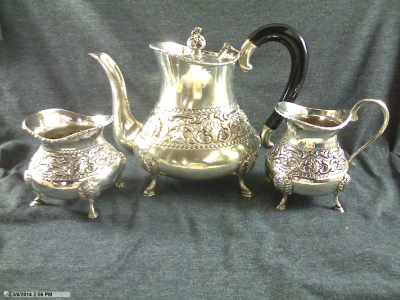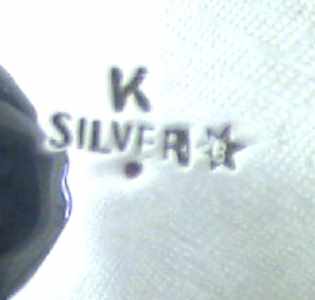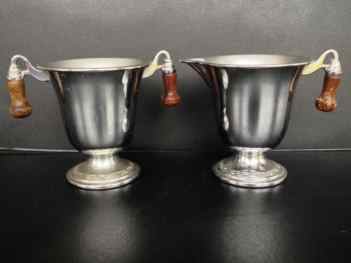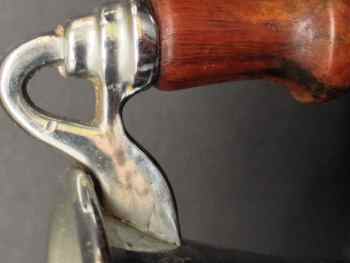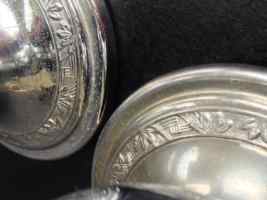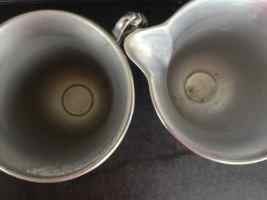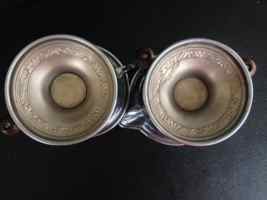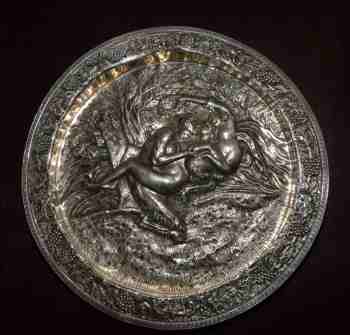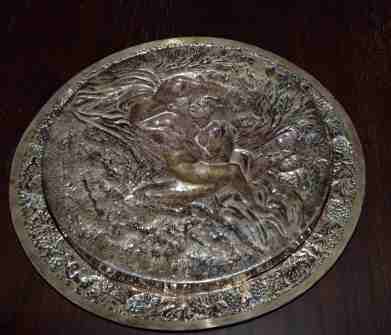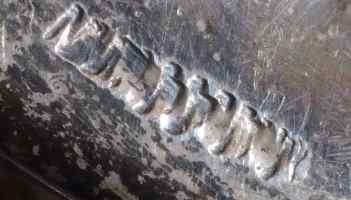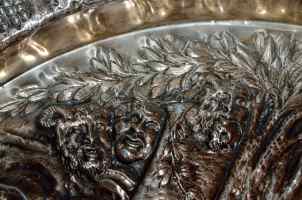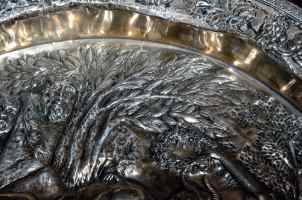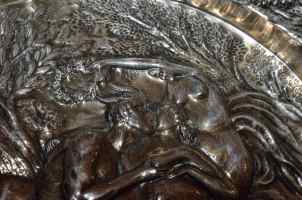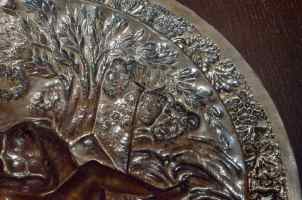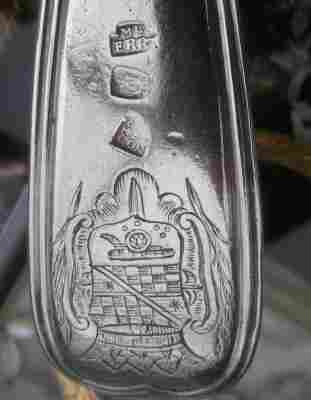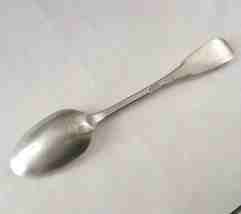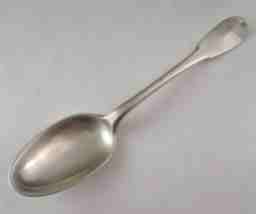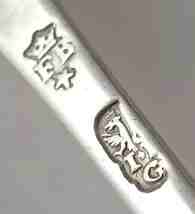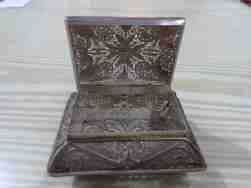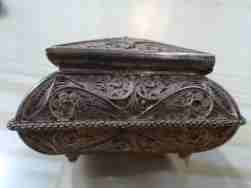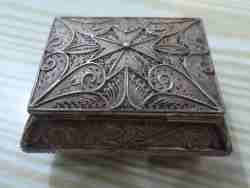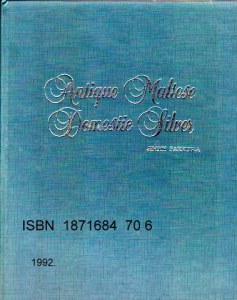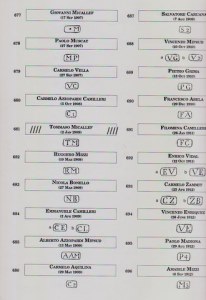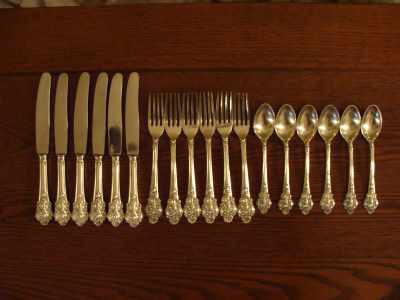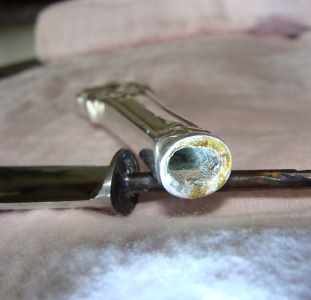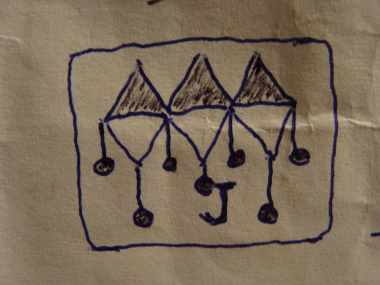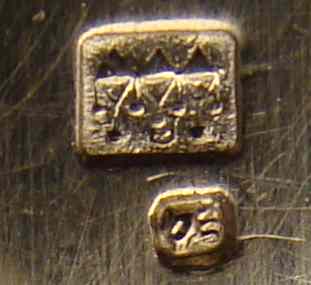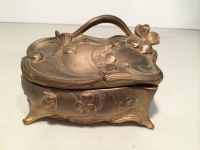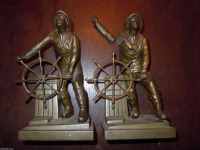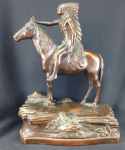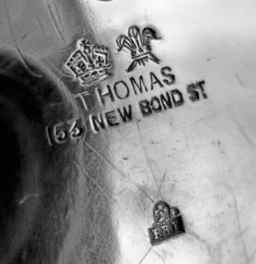
David McKinley presents:
The Duty and Exportation Marks On English Silver
Plate

Duty, of 6d. per troy oz, was first levied on plate sent
in for hallmarking in the act of 1719 which took affect
on 1st June 1720. No mark was struck on plate at this
time as a receipt for this tax although the introduction
of a crowned date letter was considered. The tax was
abolished by an Act of 1758 and, following complaints of
its inequity, was replaced by a flat fee of £2.00 per
annum levied on all makers.
The same duty was reintroduced however in 1784 and this
time receipt for the tax was identified by the striking
of a mark on all plate sent in for assay. The mark was
initially an intaglio of the monarchs bust in an
octagonal outline (Fig 1) and it came into use on the
1st December 1784. This was the Government's third
attempt to raise funds by taxing plate. In 1756 a bill
had been introduced to tax the mere possession of plate
over 100 oz. but this was found difficult to administer
and it was repealed in 1777......
click here

|
Welcome to new ASCAS members:
Tamara Adams Gathright - USA
Jose M. Boronat - USA
Paul Drewe - Australia
Carl Peterson - USA
Adelina Sallé - France
Mitch Wilkins - USA
Frank W. Wilson - England UK
Neale and Nessie Talbot-Scobie write:
...can you help? We have this tea set, teapot milk & sugar. We
do not know from whence it came.
It is stamped SILVER with the letter K above and a six pointed
star with an 8 stamped inside it at the end of "SILVER", there
is also a punched dot under "SILVER".
The set was a lucky buy and no information came with it.
We would like to know where it came from and if it is 800
silver.
Any information would be appreciated.
Thank you.
Nessie and Neale,
Manuel Ponce writes:
...Does anyone know anything about the style and when was this
salver made?
Their measures are 38,5 cm. round, 3cm high and 727gr. weight.
It has a nice patina made for the age. It has been analysed and
it is sterling silver. It was sold as produced in XIXth century.
My impression is: it was made at Spain by the end of XVIIIth to
first XIXth century or perhaps later. There are no maker's
stamps and any official assay either, may be to avoiding paying
taxes or perhaps not being the silver artisan identified, since
the scene could being censured. It seems that mostly of XVIIth
century Sevillan silver was made without any marks.
The scene of the tray represents the celebration of feast of
fertility of Lupercalia with fertility rites, with the god and
the goddess Pan, the queen of fertility, and a woman making love
with the god Pan. And the heads of three devils.
Many thanks for your help,
Manuel Ponce
Laurence Joyce writes:
...The attached photograph shows marks on a large Spanish
serving spoon for Madrid c1762 (assay master Eugenio Melcon).
I have been unable to identify the maker's mark ML/ERRZ or the
crest
Thanks for your help
Laurence Joyce
Pierre Gagnaux writes
The hallmarks on the Swiss spoon you identify are for
François Barbier(Barbin) in Geneva born in 15 November 17618 and
died the 25 June 1798, maitre orfèvre the 26 December 1749.
Pierre Gagnaux
Charles C. Cage writes
Paola Continella's spoon is Swiss, from Geneva. The mark
with the eagle (actually an eagle impaled with a key, the city
arms of Geneva) is that of the guild warden, with his initials "IIG":
Jean-Jacques Girod, who served as warden 1732-1734 and again
1760-1762. The other mark - "FB" crowned, above a star - is that
of the maker François Barbier [also Barbin] (1718-1798). As
Barbier became a master on 26 Dec 1749, the spoon must date from
warden Girod's second term, 1760-1762.
Also, as the item bears both these marks, it indicates it is of
the first standard of purity: 11 deniers (.916). [Ref:
Pierre-François deVevey, Manuel des Orfèvres de Suisse Romande (Fribourg:
Sotheby's Office du Livre, 1985), pp. 54-55 & 70. Mark 239a.]
Charles C. Cage
Christophe Ginter writes
regarding Paola Continella's request: Obviously a Swiss
spoon, sterling silver 916/1000, Geneva. The maker with initials
"FB" is François BARBIER, born in Geneva in 1718, appointed
master end of 1749.
The other mark stands for GENEVA, the initials IIG for the guild
warden ("Garde") Jean Jacques GIROD who served during two
periods, 1732-1734, then 1760-1762.
As François Barbier is registered only in 1749, it may be hence
concluded that the precise dating of the spoon is 1760-1762.
Christophe Ginter
Joseph Scerri writes
From the Book Antique Maltese Domestic Silver I found the
mark T.M. The maker is the silversmith T. Micallef, 2 Jan 1909
Joseph Scerri
Charles C. Cage writes
The maker's mark on Reg Lennox's Portuguese flatware is that
of José Lino da Rocha of Porto, registered in 1960 and converted
in 1988 to a limited liability company (José Lino da Rocha L.da).
The company is still operating, but I was not able to identify
the pattern name. [Ref: Manuel Goncalves Vidal & Fernando
Moitinho de Almeida, Marcas de Contraste e Ourives Portugueses,
v. II 1887-1993, 4th ed. (Lisbon: Impresa Nacional - Casa da
Moeda, 1997), p. 388, mark 3796.]
Charles C. Cage
Ole Lachmann writes
I own an identical cake knife. It seems to be made for the
Lily of the Valley pattern - for a number of years known in the
USA as Rose pattern.
Ole Lachmann
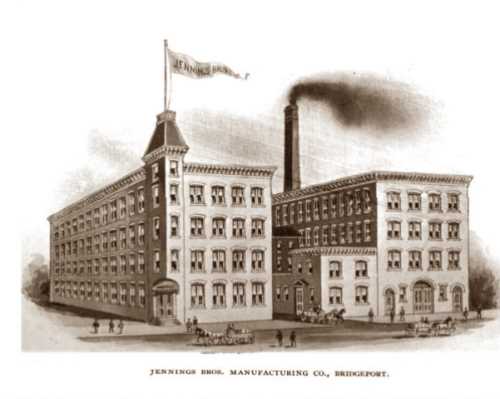
|
This month ASCAS presents an ancient image of the
factory:
JENNINGS BROS. MANUFACTURING CO BRIDGEPORT (CONN.)
The firm was founded in 1890 in Bridgeport (Conn.) as
manufacturer of jewelry boxes, candelabra, clocks,
bookends, statues and silverplate flatware. In 1906 a
salesroom was opened in New York.
Jennings produced a large variety of items made in "ormolu"
(trademark J.B. 'Ormolu Gold') and bronze ('Nouveau
Bronze'). In the 1890's/1900's the firm patented various
design in 'Art Nouveau' style for clock cases and
candelabra bases.
Jennings Bros. Mfg Co production is marked J.B.
accompanied by a factory or catalog number (3 or 4
digits). In some cases the item is marked "Trademark
J.B. Signifies the Best".
The firm went out of business in 1953 and the dies were
purchased and used by another company to manufacture
cheaper replicas of the original production.
This image is part of the
FACTORIES, PLANTS, SALESROOMS, SHOPS AND WORKSHOPS: OLD
IMAGES section of www.silvercollection.it website
|
"A WORD per MONTH"
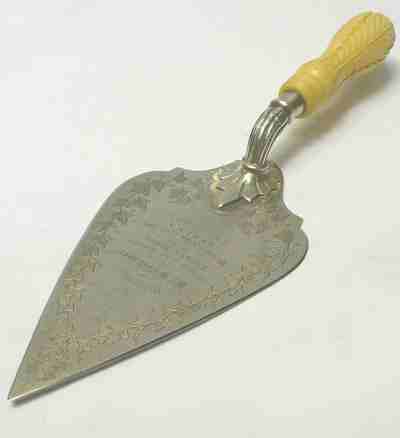
|
CEREMONIAL TROWEL
The trowel is a tool used by bricklayers having a
triangular metal blade attached to a wooden handle.
Silver or silverplate examples were used since the 19th
century in occasion of ceremonies of laying the
foundation stone of public buildings.
In this case the blade was engraved with an inscription
commemorating the event.
more
|
"A SILVERSMITH per MONTH"
|
|
F.B. THOMAS & CO
The firm had its origin in the
mid 18th century coming into control of John William
Thomas in 1848. After his death (1852) the firm was
managed by his two sons, John William Thomas II (apprenticed
to his father in 1840, obtained his freedom in 1847) and
Francis Boone Thomas. Francis Boone Thomas was
apprenticed to his father in 1847 and after his father's
death was turned to his brother John William Thomas II,
obtaining the freedom in 1854.
The firm (trading as retail silversmiths) was known as
J.W. Thomas & Son or as J.W & F.B. Thomas...
more
|
"A CREST per MONTH"
BRUCE
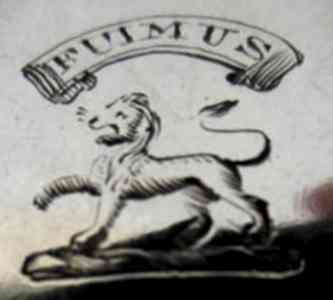
|
A crest used by Scottish and
English families.
The crest is described as a lion passant
The Latin motto is "Fuimus" (We have been)
The crest was found on a sterling silver ladle,
hallmarked Edinburgh 1812, maker Alexander Henderson

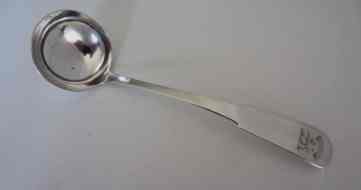 |
Closing our JULY 2014 edition of ASCAS Newsletter I hope you
have appreciated its content.
Your comments, suggestions and advice will be of great help.
My thanks to Charles C. Cage, Pierre Gagnaux, Christophe Ginter,
Laurence Joyce, Ole Lachmann, David McKinley, Audra Poland,
Manuel Ponce, Joseph Scerri, Neale and Nessie Talbot-Scobie, for
their precious contributions.
Giorgio Busetto
Secretary
DISCLAIMER AND PRIVACY POLICY
ASCAS is a community of people having a common
interest in antique silver.
It is a non-profit association without commercial links.
Membership is open to whomever has a true interest in
this subject matter.
ASCAS has no real property and no fees are requested nor
accepted from members.
ASCAS keeps in touch with its members only through
periodical newsletters, e-mails and web-site updating
and ignores and is not responsible for any other
activity pursued by its members.
Likewise, ASCAS is not responsible for opinions,
evaluation and images displayed, and in any form
published or supplied for publication, by its members
who, in any case, maintain the property of their works
and assure the respect of national and international
legislation about Intellectual Property.
ASCAS does not have the full addresses of its members (only
town, country and e-mail address are requested for
membership).
ASCAS handles and protects with care its members' e-mail
addresses, will not disclose the addresses to third
parties, will use this information only to reply to
requests received from members and for communications
strictly related to its activity.
These rules are expressly accepted by submitting the
membership request.
|
|
 newsletter
# 122 July 2014
newsletter
# 122 July 2014









